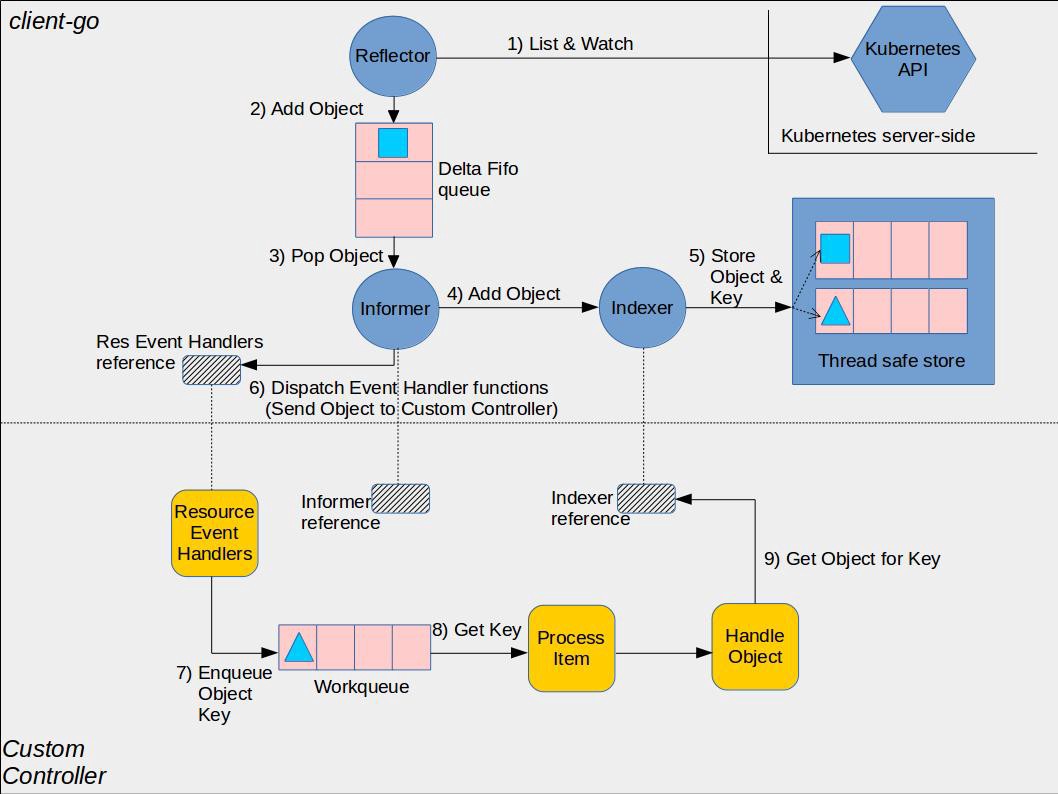以下是client-go的官方架构图

先主要针对这个Indexer来分析。
一、Indexer
Indexer保存来自api-server的资源,通过list-watch的方式来维护资源的增量变化,以这种方式来减少对api-server的直接访问,降低api-server的访问压力。
1
2
3
4
5
6
7
8
9
10
11
12
13
14
15
|
type Indexer interface {
Store
// 返回索引值值集和给定对象的索引值集相交的对象列表
Index(indexName string, obj interface{}) ([]interface{}, error)
// 返回索引值集
IndexKeys(indexName, indexedValue string) ([]string, error)
// 返回已经索引的所有索引值
ListIndexFuncValues(indexName string) []string
// 返回索引值对象
ByIndex(indexName, indexedValue string) ([]interface{}, error)
// 返回所有的索引
GetIndexers() Indexers
// 添加新的索引方法
AddIndexers(newIndexers Indexers) error
}
|
Indexer继承了Store的接口,使用多个索引扩展Store并限制存储(在删除后置空)。
它存储了三样内容:
1、存储的key,使用定义Store的接口
2、索引名称
3、索引值,用IndexFunc方法生成,这个方法使用资源对象的值来生成的。
这里有定义几个类型
1
2
3
4
|
type IndexFunc func(obj interface{}) ([]string, error)
type Index map[string]sets.String
type Indexers map[string]IndexFunc
type Indices map[string]Index
|
而接口Store定义了对象的方法
1
2
3
4
5
6
7
8
9
10
11
|
type Store interface {
Add(obj interface{}) error
Update(obj interface{}) error
Delete(obj interface{}) error
List() []interface{}
ListKeys() []string
Get(obj interface{}) (item interface{}, exists bool, err error)
GetByKey(key string) (item interface{}, exists bool, err error)
Replace([]interface{}, string) error
Resync() error
}
|
很明显,这个就是存储的增删改查的方法
二、cache
cache是Indexer接口的实现,所有对象都保存在这个cache中。
1
2
3
4
|
type cache struct {
cacheStorage ThreadSafeStore
keyFunc KeyFunc
}
|
定义了一个线程安全存储和一个计算对象键的函数。
1
2
3
4
5
6
7
8
9
10
11
12
13
|
func MetaNamespaceKeyFunc(obj interface{}) (string, error) {
if key, ok := obj.(ExplicitKey); ok {
return string(key), nil
}
meta, err := meta.Accessor(obj)
if err != nil {
return "", fmt.Errorf("object has no meta: %v", err)
}
if len(meta.GetNamespace()) > 0 {
return meta.GetNamespace() + "/" + meta.GetName(), nil
}
return meta.GetName(), nil
}
|
这个就是大部分使用的KeyFunc方法,就是取对象的元数据namespace/name。
看这个线程安全存储ThreadSafeStore。从定义上来看,增删改查的功能都是通过这个类型实现的
1
2
3
4
5
6
7
8
9
10
11
12
13
14
15
16
17
18
19
20
|
type ThreadSafeStore interface {
Add(key string, obj interface{})
Update(key string, obj interface{})
Delete(key string)
Get(key string) (item interface{}, exists bool)
List() []interface{}
ListKeys() []string
Replace(map[string]interface{}, string)
Index(indexName string, obj interface{}) ([]interface{}, error)
IndexKeys(indexName, indexKey string) ([]string, error)
ListIndexFuncValues(name string) []string
ByIndex(indexName, indexKey string) ([]interface{}, error)
GetIndexers() Indexers
// AddIndexers adds more indexers to this store. If you call this after you already have data
// in the store, the results are undefined.
AddIndexers(newIndexers Indexers) error
// Resync is a no-op and is deprecated
Resync() error
}
|
看起来和Indexer很类似,但是还有有点区别的。Indexer操作的都是资源对象,而ThreadSafeStore操作的是需要提供对象键的。
1
2
3
4
5
6
7
8
9
|
type threadSafeMap struct {
lock sync.RWMutex
// key to value
items map[string]interface{}
// 计算索引键的map
indexers Indexers
// 快速索引表,可以通过索引快速找到对象键,然后再从items中取出对象
indices Indices
}
|
而初始化实例的方法就是初始化threadSafeMap结构
1
2
3
4
5
6
7
|
func NewThreadSafeStore(indexers Indexers, indices Indices) ThreadSafeStore {
return &threadSafeMap{
items: map[string]interface{}{},
indexers: indexers,
indices: indices,
}
}
|
它的方法列表中都是关于items的增删改查,这部分没什么好说的,主要是对索引的更新。
三、实例
看到这几个定义索引的类型,用个例子来理解
1
2
3
4
5
6
7
8
9
10
11
12
13
14
15
16
17
18
19
20
21
22
23
24
25
26
27
28
29
30
|
func testIndexFunc(obj interface{}) ([]string, error) {
pod := obj.(*v1.Pod)
return []string{pod.Labels["foo"]}, nil
}
func main() {
index := NewIndexer(MetaNamespaceKeyFunc, Indexers{"testmodes": testIndexFunc})
pod1 := &v1.Pod{ObjectMeta:
metav1.ObjectMeta{Name: "one", Labels: map[string]string{"foo": "bar"}}}
pod2 := &v1.Pod{ObjectMeta:
metav1.ObjectMeta{Name: "two", Labels: map[string]string{"foo": "bar"}}}
pod3 := &v1.Pod{ObjectMeta:
metav1.ObjectMeta{Name: "tre", Labels: map[string]string{"foo": "biz"}}}
index.Add(pod1)
index.Add(pod2)
index.Add(pod3)
keys := index.ListIndexFuncValues("testmodes")
if len(keys) != 2 {
log.Fatalf("Expected 2 keys but got %v", len(keys))
}
for _, key := range keys {
if key != "bar" && key != "biz" {
log.Fatalf("Expected only 'bar' or 'biz' but got %s", key)
}
}
}
|
四、总结
所有的对象(Pod、Service等)都有属性标签(Annotations/Labels),如果属性标签就是索引键,Indexer就会把相同的属性标签的所有对象放在一个集合中,items用来存放这些资源对象,而indexers是存储索引方法,比如说就是取对象的namespace,indices就是索引表,key对应的是不同的namespace,value对应的就是资源对象名称集合。

